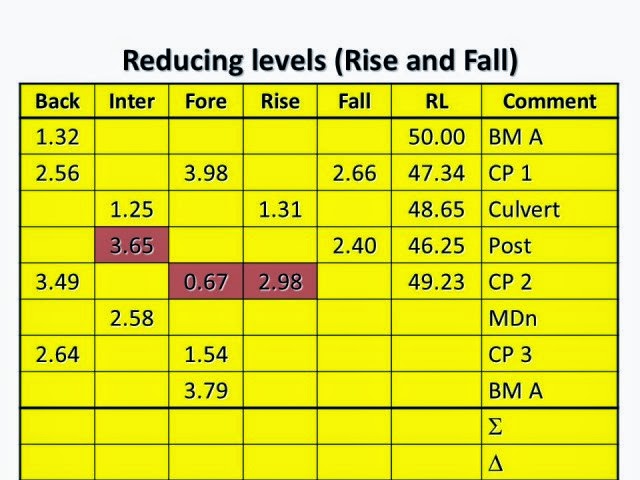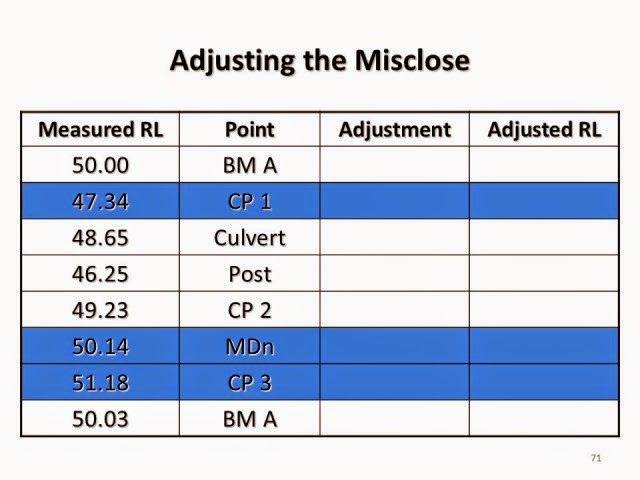CHAIN
SURVEYING
1.Only linear measurements are made
in the field
2.The principle is the provisions of
a frame work of triangles, which could be plotted to scale
3.The lengths of the sides of
triangles have to be measured
1.Generally the boundaries of the
land parcel are not straight
2. The
land parcel to be surveyed is irregular in shape
3. The
entire area is broken up into a framework of triangles (ABC & ABD)
4. The
line AB is taken right across the block, which is called the base on which all other triangles are
build up
5. In
addition 2 lines EF and EG (point E on the base is not necessarily same for 2 lines) are measured for checking
6. These
check lines do not give any additional information
7. Sometimes
they can be used to pickup internal details
8. Detail
is surveyed by rectangular offsets
NOTE:
• Unsuitable
for large areas or difficult country
• Quite
well adapted for small surveys on open ground with simple details
There
are 02 main work
• Field Work
(FW)
• Plan Work
(PW)
Field
Work (FW)
• Reconnaissance
• Examine the area
•Positions of stations are selected and marked. Inter-visibility can be checked using ranging poles
•A sketch of the land showing the arrangement of lines and the numbering or lettering of the stations must be prepared
• Selecting Stations (The following requirement must be fulfilled)
•Survey lines should be as few as practicable, and such that the framework can be plotted
•Normally baseline should be run middle of the area. Triangles are build up on the base
•The triangles should be well conditioned
•Each triangle must have a check line
•As few lines as possible should have to be run without offsets
•Offsets should be short for locating important features
• Examine the area
•Positions of stations are selected and marked. Inter-visibility can be checked using ranging poles
•A sketch of the land showing the arrangement of lines and the numbering or lettering of the stations must be prepared
• Selecting Stations (The following requirement must be fulfilled)
•Survey lines should be as few as practicable, and such that the framework can be plotted
•Normally baseline should be run middle of the area. Triangles are build up on the base
•The triangles should be well conditioned
•Each triangle must have a check line
•As few lines as possible should have to be run without offsets
•Offsets should be short for locating important features
•Selecting Stations (The following
requirement must be fulfilled)
•Obstacles for ranging and chaining should
be avoided as far as possible
•Lines should be lie over the more level
ground
NOTE: Care should be taken when working along the road
•Marking Stations
•Wooden
Pickets (WP) may be used
•Cement
Pickets (CP) can be used when more durability is required
•Running Survey Lines & Survey
of Details
•The routine of running a survey line comprises of the chaining of the line & location of the adjacent detail
•Offsets will be taken by estimating the perpendicularity by eye & reads out the lengths of the offsets and chainages
•Also the chainages along the chain line at which boundaries (fence, stream, etc.) are intersected by the chain line should be noted
•Field Book Keeping
•There are many regulations for Field Book keeping and you must follow all the regulations
•If not appropriate actions will be taken
•Please go through all the regulations
•The routine of running a survey line comprises of the chaining of the line & location of the adjacent detail
•Offsets will be taken by estimating the perpendicularity by eye & reads out the lengths of the offsets and chainages
•Also the chainages along the chain line at which boundaries (fence, stream, etc.) are intersected by the chain line should be noted
•Field Book Keeping
•There are many regulations for Field Book keeping and you must follow all the regulations
•If not appropriate actions will be taken
•Please go through all the regulations
Plan
Work (PW)
•Pencils
of 3H or 4H should be used
•Scale
must be decided (Indeed this must be decided before proceeding to the field,
because the accuracy & precision, which the data to be collected in the
field accordingly)
•Other
items to be used for plan work are Plotting Scale, Offset Scale, Parallel
Ruler, and A3 size Plan Sheet (Quarter Field Sheet) and Drawing Pen for inking
Basic Requirements of Maps
•Clear
•Correct
•Unambiguous
•Dimensioned
(or scaled)
•Use
of Standard Symbols
Scale
•Scale
is the relationship between size on the map and size on the ground
–Once centimetre on the map equals
100 metres on the ground, 1:10,000
•A
bar
scale represents this graphically
–Necessary as plans can be enlarged
easily
•A
good reference can be found here:
•When
plotted there MUST be 2 scale notations:
–The
natural scale, 1:100
–A bar
scale
Border
•Although
it is not necessary to ‘frame’ a plan, it is essential to include other
information like:
–Who
–When
–Where
–Why
–Sheet number…
•See
the Specimen plan in notice board
North
•There
needs to be a north arrow
–There
may also be a grid showing regular intervals of the coordinate system
•The
North datum needs to be noted
–MGA/AMG
–Magnetic
–True
–Arbitrary
Lettering, Significant Figures
•There
are requirements for particular letter sizes depending on the:
–Scale
of the plan
–Importance
of the feature
–Legal
requirement
•For
large scale plans (like we are making), there are recommended significant figures for height and coordinate display





















































































































